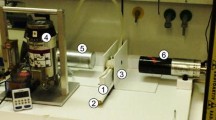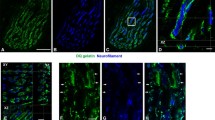Abstract
The four principal molecular forms of acetylcholinesterase characteristic of the mammalian muscle (16.1 S., 12.5 S, 10.2 S, and 3.6. S) were identified by sucrose gradient sedimentation as the four activity peaks H, H1, M and L.
After denervation obtained by crushing the sciatic nerve five stages of the denervation-reinnervation process were examined. Days 7, 14, 22, 30, and 60 were chosen on the basis of previous electrophysiological and histochemical studies. The AChE activity showed an initial drop followed by recovery after nerve arrival at the muscle which was completed by day 60. Marked changes in the relative proportions of the four molecular forms were observed. The 16.1 S almost disappeared during the denervation period, reappeared after nerve arrival and was completely restored at day 60. Changes were also observed in the intermediate and lower forms and were tentatively related to processes of degradation, reaggregation and de novo synthesis.
A comparison of the present data with those from parallel electrophysiological and histochemical studies suggests the presence and the functional role of molecular forms other than 16S in the neuromuscular junction.
Similar content being viewed by others
References
Carmignoto, G., Finesso, M., Tredese, L., andGorio, A., 1981. Transmitter release mechanisms during the early stages of reinnervation of a fast twitch muscle of the rat. Effect of ganglioside treatment.In Bloch, K., Bolis, L., andTosteson, D. C. (eds.), Membranes, Molecules, Toxins and Cells, PSG Publishing, Littleton, (in press).
Gorio, A., Carmignoto, G., andFerrari, G. 1981. Axonal sprouting stimulated by gangliosides. A new model for elongation and sprouting. Pages 177–195,in Gorio, A., andRapport, M. (eds.), Gangliosides in Neurological and Neuromuscular Function. Development and Repair, Raven Press, New York.
Gorio, A., Carmignoto, G., Facci, L., andFinesso, M. 1980. Motor nerve sprouting induced by ganglioside treatment. Possible implications for gangliosides on neuronal growth. Brain Res. 197:236–241.
Silman, I., Lyles, J. M., andBarnard, E. A. 1978. Intrinsic forms of acetylcholinesterase in skeletal muscle. FEBS Lett. 94:166–170.
Paggi, P., Scarsella, G., andToschi, G. 1977. Multiple forms of acetylcholinesterase in the ciliary ganglion and iris of the pigeon. Neuroscience 2:1085–1093.
Scarsella, G., Toschi, G., Chiappinelli, V. A., andGiacobini, E. 1978. Molecular forms of acetylcholinesterase in the ciliary ganglion and iris of the chick. Dev. Neurosci. 1:133–141.
Carson, S., Bon, S., Vigny, M., Massoulié, J., andFardeau, M. 1979. Distribution of acetylcholinesterase molecular forms in neuronal and non-neuronal sections of human muscle. FEBS Lett. 97:348–352.
Hall, Z. W. 1973. Multiple forms of acetylcholinesterase and their distribution in endplate and non-endplate regions of rat diaphragm muscle. J. Neurobiol. 4:343–361.
Weinberg, C. B., andHall, Z. W. 1979. Junctional form of acetylcholinesterase restored at nerve-free endplates. Develop. Biol. 68:631–635.
Vigny, M., Koenig, J., andRieger, F. 1976. The motor endplate specific form of acetylcholinesterase: appearance during the embryogenesis and reinnervation of rat muscle. J. Neurochem. 27:1347–1353.
Vigny, M., Di Giamberardino, L., Couraud, J. Y., Rieger, F., andKoenig, J. 1976. Molecular forms of chicken acetylcholinesterase: effect of denervation. FEBS Lett. 69:277–280.
Ellman, G. L., Courtney, K. D., Andres, V., andFeatherstone, R. M. 1961. A new and rapid colorimetric determination of acetylcholinesterase activity. Biochem. Pharmacol. 7:88–95.
Chubb, I. W., andSmith, A. D. 1975. Isoenzymes of soluble and membrane-bound acetylcholinesterase in bovine splanchnic nerve and adrenal medulla. Proc. R. Soc. Lond. B. 191:245–261.
Bon, S., Vigny, M., andMassoulié, J. 1979. Asymmetric and globular forms of acetylcholinesterase in mammals and birds. Proc. Natl. Acad. Sci. 76:2546–2550.
Ranish, N. A., Kiauta, T., andDettbarn, W. D. 1979. Axotomy induced changes in cholinergic enzymes in rat nerve and muscles. J. Neurochem. 32:1157–1164.
Di Giamberardino, L., andCouraud, J. Y. 1978. Rapid accumulation of high molecular weight acetylcholinesterase in transected sciatic nerve. Nature 271:170–172.
Author information
Authors and Affiliations
Rights and permissions
About this article
Cite this article
Senni, M.I., Biagioni, S., Marini, P. et al. Acetylcholinesterase activity and molecular forms during denervation and reinnervation in extensor digitorum longus muscle of the rat. Neurochem Res 6, 1291–1298 (1981). https://doi.org/10.1007/BF00964350
Accepted:
Issue Date:
DOI: https://doi.org/10.1007/BF00964350




